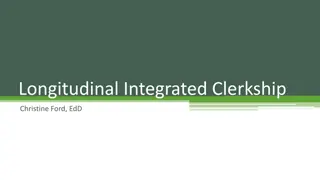
Optimal Models and Administration of Longitudinal Integrated Clerkships at UWSOM
Explore recommendations for the optimal models and efficient administration of Longitudinal Integrated Clerkships (LICs) at UWSOM, based on trends and outcomes in medical education programs. The proposal includes three distinct paths to enhance learning experiences and streamline curriculum management, focusing on urban and rural settings, multi-specialty LICs, and specialty-based training. Specific recommendations aim to improve congruence in learning outcomes, assessment, and evaluation methods for LICs.
Download Presentation

Please find below an Image/Link to download the presentation.
The content on the website is provided AS IS for your information and personal use only. It may not be sold, licensed, or shared on other websites without obtaining consent from the author. If you encounter any issues during the download, it is possible that the publisher has removed the file from their server.
You are allowed to download the files provided on this website for personal or commercial use, subject to the condition that they are used lawfully. All files are the property of their respective owners.
The content on the website is provided AS IS for your information and personal use only. It may not be sold, licensed, or shared on other websites without obtaining consent from the author.
E N D
Presentation Transcript
LIC Workgroup Frank Batcha, MD Co-Chair Jennifer Wright, MD Co-Chair Daniel Bechtold, MD Danielle Bienz, MEd Heidi Combs, MD, MS Daniel Cornish, MD Barb Doty, MD Kellie Engle Jay Erickson, MD Michelle Fleming Janelle Strampe, MS4 Laura Goodell, MD Constance Lamb Katie Martin, MD Christina Marchion, MD Vicki Mendiratta, MD Richard Shugerman, MD Sarah Wood
Charge Make a recommendation to the Curriculum Committee about the optimal model(s) for Longitudinal Integrated Clerkships (LIC) at UWSOM. Make a recommendation to the Curriculum Committee regarding the efficient administration of LICs; where the responsibility for the curriculum should lie, oversight, learning objectives, assessment and evaluation and congruence in learning outcomes.
Background Contacted 10 programs Trend of more institutions developing LICs or expanding existing LICs Equivalent outcomes compared with block style clerkships USMLE scores NBME test scores Clinical grades Hypothesis that this is a better structure for teaching medicine Multi-specialty LICs Most common Generally 10-12 months in length Interspersed inpatient bursts 2-4 weeks long Few students participating to the whole class Single specialty LICs Much less common (U of Minn) Focused on rural and primary care workforce needs
Recommendation: 3 paths Traditional blocked clerkships Departmentally based blocks Urban and rural sites Multi-specialty LICs Olympia LIC model Integrated departmentally based outpatient with interspersed inpatient experiences Entire Patient Care phase Urban or small city setting goal to have in each region Common structure to streamline administration Single-specialty LICs WRITE model (expanded) TRUST as separate LCME Track WRITE as separate non-departmental course Focused on developing skills for rural primary care practitioners
WRITE/TRUST specific recommendations TRUST as an independent parallel LCME Track, with it s own Curriculum Objectives Grading WRITE as separate course, distinct from current clerkship model Departments sharing learning objectives WRITE leadership responsible for determining objectives to apply Use of NBME subject exams would help with congruence Inpatient experiences Distinct from traditional clerkships Specialty based Specifically created to pair with other WRITE experiences May be located in regional communities Closer to WRITE sites Ease of scheduling Embedded in communities More focused on rural education






















